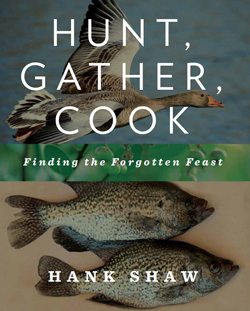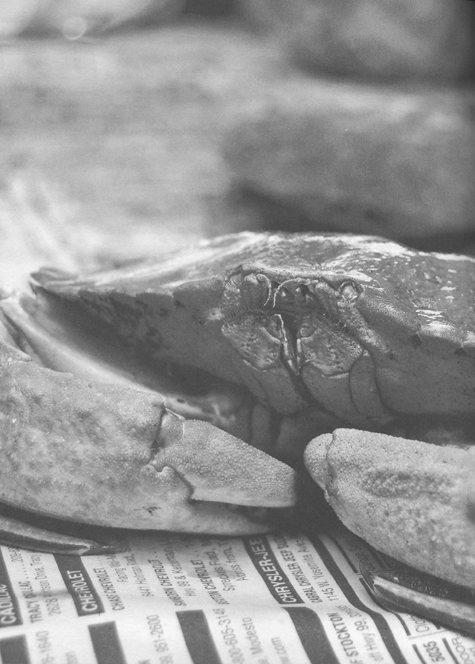Hunt, Gather, Cook

Intro to wild game
Over the years I’ve looked at a number of books on hunting, fishing, and foraging, but this turns out to be my favorite. The first sentence: “We live in an edible world.”
There is good info on things like aging game birds, gutting and skinning a deer, even how to get started hunting. Or how to net herring — an annual ritual in NorCal. For the boatless, this can be practiced from shore with a cast net, 5-gallon bucket, and hip boots. Onto harvesting clams, rock crabs, rock fish. How to kill eels with salt (almost impossible otherwise), manzanita cider, madrone bark tea. Making sausage from wild boar, eating squirrels, (there’s a bluegrass song, “Why Would Anyone Eat Beef When They Can Have squirrel?”), and recipes for everything.
01/3/14Excerpt

*
Catching crabs is pretty easy. You need bait, a cooler, some string, and patience. A trap of some sort helps a lot, but I've caught crabs hand-lining a chicken leg off a rowboat in a back bay or off a dock. You lower the chicken to the bottom and wait until you feel little tugs. Slowly bring the line up, and if you see a crab munching on the chicken, you carefully slip a net underneath him-he'll let go of the chicken as soon as he sees you or the boat.
Trap crabbing is basically a combination line and net. You toss the trap in and wait, then haul it in from time to time. Remove crabs from the trap and toss them in a cooler. Repeat as necessary.
Where to go? Piers are good places, as are jetties or breakwaters. You want to put the trap near places where crabs hide. They will run out and start eating your bait, and you can collect them. If you have a boat, look for underwater grass beds near rocks.
*
Always be ready. Rabbit hunting is an exercise in active relaxation. You never know when a rabbit or hare will show itself, and then you might only have a second to make the shot. Peering intently at everything will wear you out in an hour, so you need to let yourself go and absorb everything as you slowly move through an area. Listen. You can often hear rabbits before you can see them. I've heard rabbits chewing before I could spot them.
…Above all, watch. Don't look for the body of the rabbit or the hare, look for its eye or an ear. I've spotted hares staring at me that were standing stock-still. I never saw the hare; his coat melted into the surrounding scrub, but his eyes looked like polished pebbles. Aim for the head, especially with a shotgun. A full blast with a shotgun in the body can destroy the meat on a rabbit or squirrel. A head shot is both more humane and wastes less meat. Remember, the most and best meat in any of these animals is in their back legs.
*
Aging Game Birds
I used to recoil at the idea of hanging shot pheasants or partridges ungutted and in their feathers for days. It did not seem terribly hygienic or sane to me. Old texts wax rhapsodic about the sublime flavor of "high" game, which usually means pheasants that have hung for more than a week. This, I'd decided, was madness. I was wrong.
*

*
Fortunately, science exists on the topic of hanging game birds. My best source is an Australian government publication that did some rigorous experiments. Pheasants hung for 9 days at 50°F have been found by taste panels to be more acceptable than those hung for 4 days at 59°F or for 18 days at 41°F. The taste panels thought that the birds stored at 59°F were tougher than those held for longer periods at lower temperatures. Pheasants hung at 50°F became more gamy in flavor and more tender with length of hanging.
A few things you should know. First, aging works with any game bird. The general rule is the larger the bird, the longer you can hang it. Doves and quail need just a day or so, while grouse, partridges, woodcock, and pigeons can go as long as 5 days. Don't try to wet-pluck an aged game bird. You must dry-pluck these birds because the skin gets looser, and scalding (more on this ahead) does not seem to help with the feathers. It was a major bummer to scald one bird and rip some of the skin. Dry-plucking, you should be warned, takes forever, but the results are worth it.
Hunt, Gather, Cook Hank Shaw 2012, 336 pages $14






